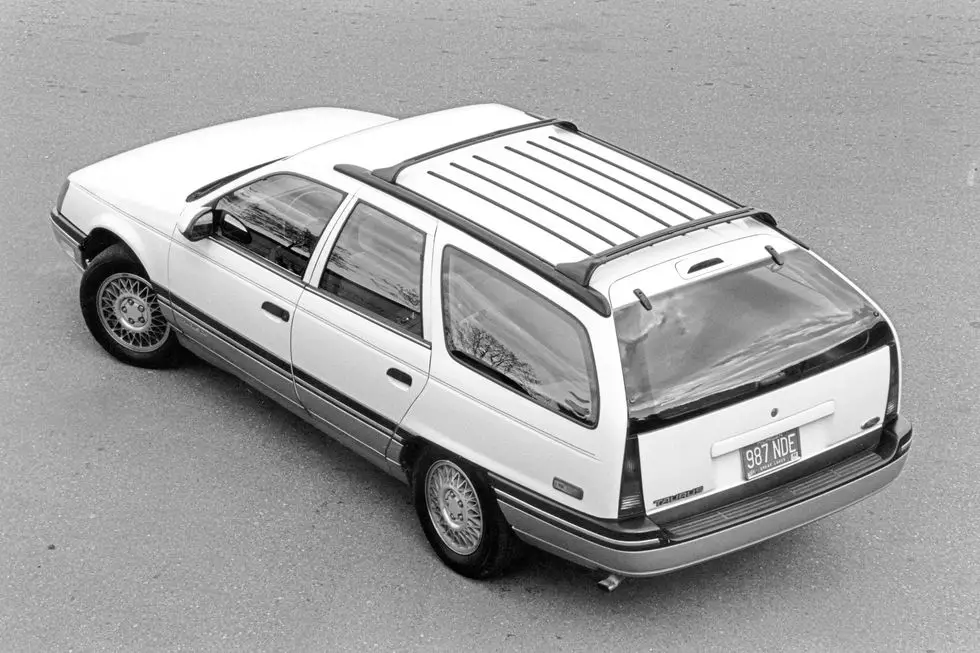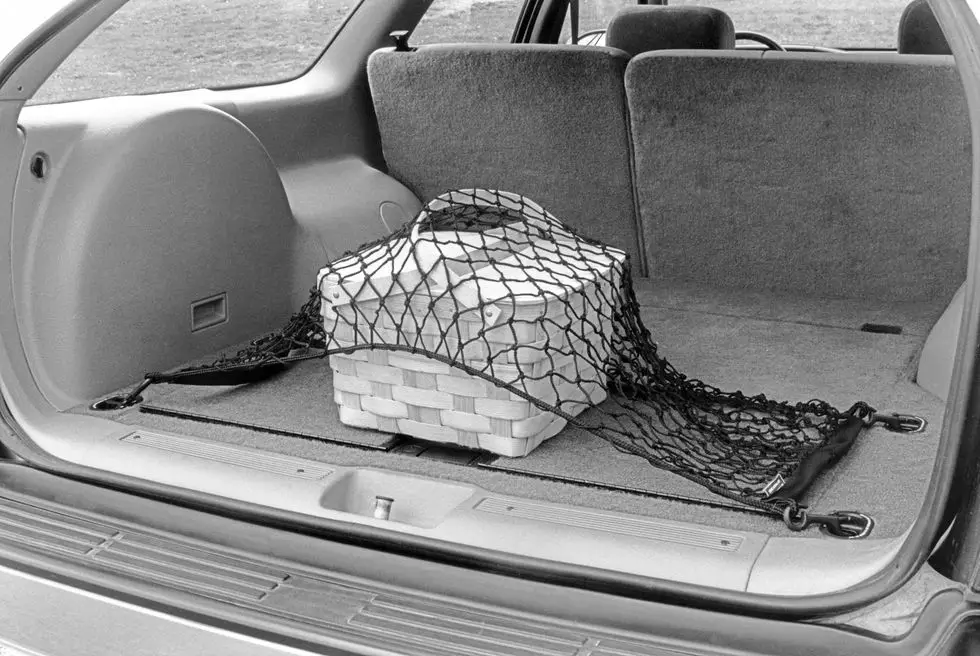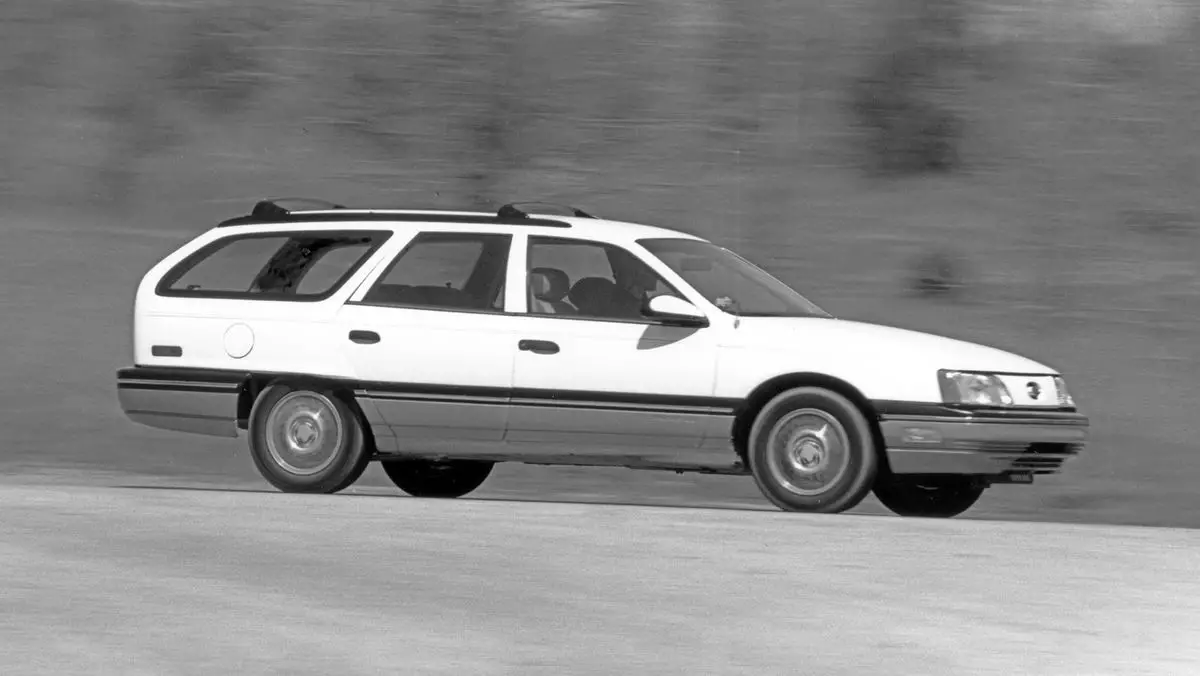A New Era for Station Wagons
The 1986 Ford Taurus LX Wagon marks a significant transformation in the realm of station wagons, stepping away from the traditional image of its predecessor, the Ford Country Squire. With its sleek design and modern features, the Taurus LX Wagon redefines what a family car can be, blending practicality with style. This shift not only caters to the needs of suburban families but also captures the attention of car enthusiasts who typically gravitate towards sportier models.
Ford’s innovative approach with the 1986 Taurus LX Wagon has successfully challenged the mundane perception of station wagons, presenting a vehicle that is both functional and visually appealing. The updated aesthetics, combined with advanced engineering, signal a new era where station wagons can command admiration and respect on the road. This model is not just a transportation solution; it is a statement of forward-thinking design and versatility.
As part of Car and Driver’s 30,000-mile test fleet, the 1986 Ford Taurus LX Wagon promises to deliver a comprehensive evaluation of its performance, reliability, and overall driving experience. This extensive testing phase will provide valuable insights and highlight the strengths and potential areas for improvement in this suburban classic. By undergoing rigorous testing, the Taurus LX Wagon aims to prove its worth not just as a practical family car, but as a vehicle that meets diverse driving needs and preferences.
The introduction of the 1986 Ford Taurus LX Wagon signifies more than just an upgrade from the Country Squire; it represents a bold move towards redefining family-oriented vehicles. This station wagon is poised to set new standards and expectations, paving the way for future innovations in the automotive industry.
The Legacy of Ford Station Wagons
Ford’s station wagons have long been a significant part of American automotive history, with their roots tracing back to the wood-sided cars of the 1920s, 1930s, and 1940s. These early models, often referred to as “woodies,” were crafted with wooden panels and became synonymous with a rugged yet sophisticated style. They catered to families and businesses alike, offering ample space and utility. As the decades progressed, the design and features of Ford’s station wagons evolved, reflecting changing consumer preferences and advancements in automotive technology.
In the 1960s, Ford introduced the Country Squire, a model that would become an iconic symbol of suburban success. With its woodyesque design, the Country Squire combined the nostalgic appeal of earlier models with modern conveniences, making it a favorite among families. The spacious interior, powerful engine options, and distinctive styling set it apart from competitors and solidified its place in American culture. The Country Squire was more than just a vehicle; it was a statement of prosperity and a testament to Ford’s ability to innovate and lead in the station wagon market.
Throughout the decades, Ford continued to adapt and improve its station wagon offerings. The company’s dedication to quality and innovation ensured that each new model built upon the legacy of its predecessors. From the wood-sided classics to the sleek and modern designs of the later years, Ford’s station wagons have consistently been trendsetters. They have not only met the needs of the contemporary consumer but have also become cherished icons in automotive history.
The 1986 Ford Taurus LX Wagon is a prime example of Ford’s commitment to excellence in this segment. It embodies the rich heritage of Ford station wagons while introducing new features and design elements that appeal to a modern audience. As we delve deeper into the specifics of the 1986 model, it’s essential to appreciate the historical context and legacy that paved the way for its creation.

Design and Styling: From Functional to Fashionable
The transformation from the bulky and utilitarian Country Squire to the sleek and attractive 1986 Ford Taurus LX Wagon marks a significant milestone in automotive design. The Taurus LX Wagon shed the traditional station wagon’s cumbersome image, trading the simulated wood-grain panels for a more modern and aerodynamic exterior. This redesign was not merely cosmetic; it represented a fundamental shift in how station wagons were perceived in the suburban landscape.
With its smooth, curved lines and streamlined silhouette, the Taurus LX Wagon introduced a fresh aesthetic that appealed to a broader audience. The vehicle’s exterior featured flush-mounted headlights and a lack of excessive ornamentation, which contributed to its contemporary look. This aerodynamic approach not only enhanced the vehicle’s visual appeal but also improved its fuel efficiency, aligning with the growing consumer preference for cars that were both stylish and economical.
The design evolution of the Taurus LX Wagon made a bold statement, distinguishing it from its predecessors and competitors. The emphasis on sleekness and modernity was evident in every aspect of its styling, from the front grille to the rear bumper. This attention to detail extended to the color palette offered, with sophisticated hues that complemented its refined design. These changes helped reposition the station wagon as a desirable option for families, blending practicality with an unexpected level of sophistication.
In a suburban landscape where functionality often took precedence over form, the 1986 Ford Taurus LX Wagon emerged as a fashionable alternative. Its innovative design demonstrated that station wagons could be both functional and visually appealing, challenging the stereotypes associated with this vehicle category. The Taurus LX Wagon thus played a pivotal role in redefining suburban automotive trends, making station wagons fashionable once again.
Interior Comfort and Features
The 1986 Ford Taurus LX Wagon was designed with the modern family in mind, delivering a spacious and comfortable interior that set new standards in the automotive industry. The cabin of the Taurus LX Wagon is notably roomy, with ample seating for up to seven passengers, thanks to its innovative seating configuration. The second and third rows of seats can be folded flat, providing an impressive amount of cargo space, making it ideal for family trips, grocery runs, or even transporting larger items.
Comfort was a key focus in the design of the Taurus LX Wagon. The seats are upholstered in high-quality materials that offer both durability and luxury. The front seats are well-cushioned and supportive, ensuring a pleasant ride even on longer journeys. For added convenience, the driver’s seat can be adjusted in multiple ways, allowing for a personalized and ergonomic driving position. Additionally, the rear passengers benefit from ample legroom and headroom, making the Taurus LX Wagon a comfortable choice for passengers of all ages.
One of the standout features of the 1986 Ford Taurus LX Wagon is its modern dashboard design, which was ahead of its time. The dashboard is intuitively laid out, with easily accessible controls and a clear, uncluttered appearance. The use of quality materials throughout the interior adds to the overall sense of luxury, while thoughtful touches, such as well-placed storage compartments and cup holders, enhance practicality.
Innovative storage solutions are another highlight of the Taurus LX Wagon. The vehicle boasts numerous storage options, including a spacious glove compartment, door pockets, and under-seat storage, ensuring that there is a place for everything a family might need on the go. These features, combined with the car’s practical design and luxurious touches, make the 1986 Ford Taurus LX Wagon a standout choice for families seeking both functionality and comfort in their vehicle.
Performance and Handling
The 1986 Ford Taurus LX Wagon stands out in the realm of station wagons with its impressive performance and handling features. Under the hood, this suburban classic is powered by a 3.0-liter V6 engine, generating a respectable 140 horsepower and 160 lb-ft of torque. These specifications might seem modest by today’s standards, but for a vehicle of its class and era, they provided a robust and reliable driving experience. The engine’s smooth power delivery, coupled with a four-speed automatic transmission, ensured a seamless and efficient drive, making it suitable for both daily commutes and long family road trips.
When it comes to handling, the Taurus LX Wagon defies the expectations typically associated with station wagons. Its front-wheel-drive configuration contributes to a balanced and stable ride, while the independent front suspension and semi-independent rear setup enhance overall ride quality. The steering is responsive and precise, allowing for confident maneuvering in various driving conditions. Whether navigating suburban streets or cruising on the highway, the Taurus LX Wagon offers a composed and comfortable driving experience.
Comparing the performance of the 1986 Ford Taurus LX Wagon to other station wagons of the same era highlights its superiority. Many contemporaries were burdened with sluggish acceleration and uninspiring handling, whereas the Taurus LX Wagon delivered a more dynamic and engaging drive. Furthermore, when pitted against some sportier cars of the mid-1980s, the Taurus LX Wagon held its own, offering a blend of practicality and performance that was rare for station wagons at the time.
In summary, the 1986 Ford Taurus LX Wagon managed to break the mold of traditional station wagons with its commendable performance and handling characteristics. Its capable engine, refined ride quality, and responsive handling set it apart from its peers, making it a standout choice for drivers seeking both functionality and driving enjoyment.

Safety and Reliability
The 1986 Ford Taurus LX Wagon was designed with family safety as a paramount concern. This model was equipped with essential safety features that were advanced for its time, offering a sense of security to drivers and passengers alike. One of the primary safety elements of this vehicle included the seat belts, which were designed to provide maximum restraint in the event of a collision. Although airbags were not yet a standard feature in vehicles during the mid-1980s, the Taurus LX Wagon’s robust structure and extensive crumple zones aimed to minimize impact forces on occupants.
Another significant safety feature of the 1986 Ford Taurus LX Wagon was its braking system. This model came with a reliable set of power-assisted front disc brakes and rear drum brakes, ensuring effective stopping power. The anti-lock braking system (ABS) was not standard in the 1986 model, but the conventional braking system offered adequate performance for its era, contributing to the overall safety of the vehicle.
In terms of reliability, the Ford Taurus LX Wagon has garnered a reputation for being a dependable family car. Data from various automotive reliability studies and user reviews have indicated that the vehicle performed consistently well over the years. Additionally, the ongoing 30,000-mile test conducted on the 1986 Ford Taurus LX Wagon has demonstrated its durability and reliability under various driving conditions. This long-term testing has provided valuable insights into the vehicle’s performance, highlighting its robustness and minimal maintenance requirements.
These safety and reliability factors significantly enhance the 1986 Ford Taurus LX Wagon’s appeal as a family car. Potential buyers can take comfort in knowing that this vehicle was designed with their safety in mind and has stood the test of time in terms of reliability. Such attributes make the Taurus LX Wagon a practical choice for families seeking peace of mind on the road.
Market Reception and Impact
Upon its release in 1986, the Ford Taurus LX Wagon received a warm reception from both consumers and critics, significantly impacting the station wagon market. The Taurus LX Wagon’s innovative design and advanced features contributed to its immediate popularity, with sales figures reflecting its success. In its first year, Ford reported over 200,000 units sold, a testament to the vehicle’s appeal and market demand.
Customer reviews were overwhelmingly positive, with many praising the Taurus LX Wagon for its spacious interior, advanced technology, and reliable performance. Families appreciated the ample cargo space and comfortable seating arrangement, while tech enthusiasts lauded the vehicle’s cutting-edge features, such as its electronic digital dashboard, which was a novelty at the time.
Critical acclaim further bolstered the Taurus LX Wagon’s reputation. It garnered several prestigious awards, including the “Motor Trend Car of the Year” in 1986. Such accolades not only validated the vehicle’s quality but also elevated its status within the automotive industry. The Taurus LX Wagon’s success demonstrated Ford’s ability to innovate and adapt, significantly enhancing the brand’s image.
The introduction of the Taurus LX Wagon marked a pivotal moment in the evolution of the station wagon market. Prior to its release, station wagons were often perceived as mundane and uninspired family vehicles. However, the Taurus LX Wagon’s sleek design, coupled with its practicality, challenged these stereotypes and redefined public perception. It set a new benchmark for family-oriented vehicles, combining style with functionality.
In summary, the 1986 Ford Taurus LX Wagon played a crucial role in revitalizing the station wagon market. Its impressive sales figures, positive customer reviews, and critical acclaim underscored its success. The vehicle not only influenced consumer expectations but also strengthened Ford’s brand image, solidifying its place as a pioneer in automotive innovation.

Conclusion: The Future of Station Wagons
The 1986 Ford Taurus LX Wagon undeniably marked a transformative period in the evolution of station wagons. With its aerodynamic design, enhanced comfort, and advanced features, the Taurus LX Wagon challenged traditional perceptions, setting new standards for both aesthetics and functionality in family vehicles. This model stood as a testament to Ford’s innovative approach, seamlessly blending practicality with modernity, which resonated profoundly with suburban families seeking more than just a utilitarian transport solution.
As we look towards the future of station wagons, the legacy of the 1986 Ford Taurus LX Wagon offers a blueprint for innovation and adaptation. The station wagon market, though overshadowed in recent years by the rise of SUVs and crossovers, possesses untapped potential for resurgence. Future models could draw inspiration from the Taurus LX Wagon’s pioneering spirit, incorporating cutting-edge technology, sustainable practices, and design elements that cater to contemporary lifestyles. Hybrid and electric powertrains, advanced driver-assistance systems, and customizable interiors are just some of the advancements that could redefine the station wagon’s role in the automotive landscape.
The enduring legacy of Ford’s station wagons, particularly the Taurus LX Wagon, underscores their significant role in automotive history. They have not only provided reliable and versatile transportation but have also reflected broader social and technological trends. As automakers continue to innovate, the principles that guided the creation of the 1986 Ford Taurus LX Wagon—commitment to quality, customer-centric design, and forward-thinking innovation—will remain crucial. The Taurus LX Wagon’s impact is a reminder of how a well-conceived vehicle can transcend its era, leaving a lasting imprint on both the market and the collective memory of car enthusiasts and everyday drivers alike.

